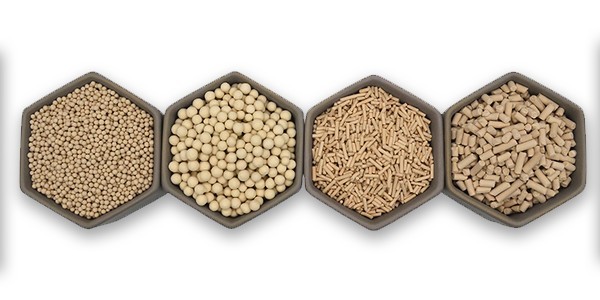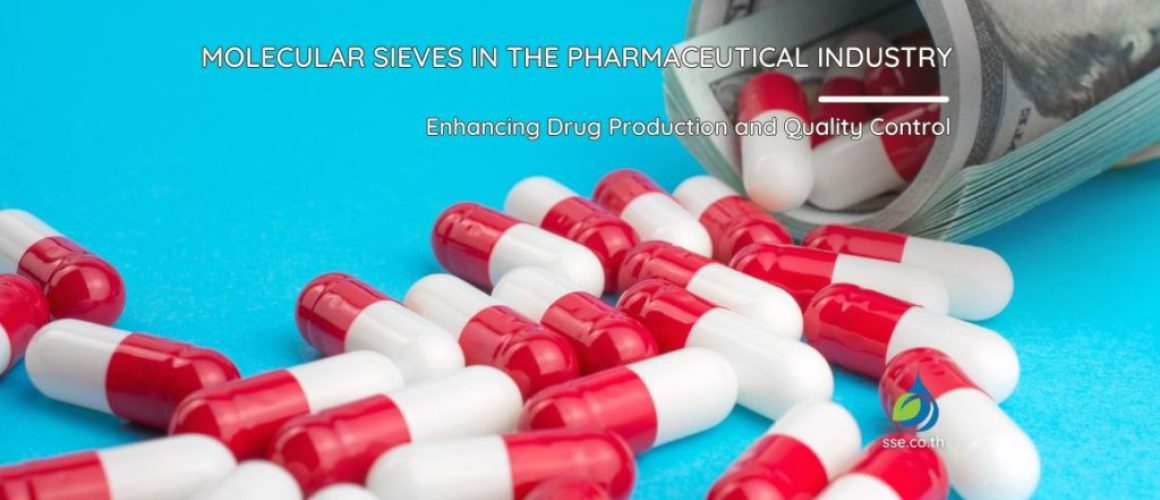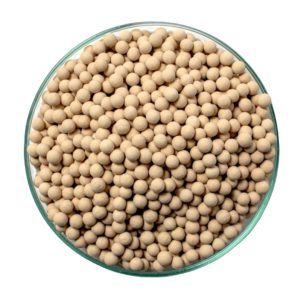Molecular Sieves in the Pharmaceutical Industry


| Section | Key Takeaways |
|---|---|
| Molecular Sieves in Drug Production | Essential for solvent drying, purification, and separation of compounds, ensuring high-quality active pharmaceutical ingredients (APIs). |
| Molecular Sieves in Pharmaceutical Packaging | Provides moisture, oxygen, and odor control, extending the shelf life and maintaining the quality of sensitive products. |
| Types of Molecular Sieves | Different types (3A, 4A, 5A, 13X) serve specific pharmaceutical needs, from drying to complex separation processes. |
| Regeneration and Reuse | Cost-effective regeneration methods, such as heat treatment and vacuum desorption, enable reuse, reducing operational costs. |
| Environmental Impact | Reusable and eco-friendly, molecular sieves support sustainability and meet environmental regulations in pharmaceutical applications. |
| Comparison with Other Desiccants | Superior adsorption capacity and targeted contaminant control make molecular sieves a preferred choice over silica gel and other desiccants. |
| Advantages in Pharmaceuticals | High adsorption capacity, selective adsorption, and stability provide essential benefits for pharmaceutical quality control. |
| Future Innovations | Advances in biocompatible materials, improved selectivity, and expanded applications promise enhanced pharmaceutical uses. |
Table of Contents
“Molecular sieves act as precision filters in pharmaceuticals, ensuring that every step in drug production meets the highest standards of purity and stability.”
Introduction
Molecular sieves play a vital role in the pharmaceutical industry, where quality and purity are paramount. These highly efficient adsorbents remove moisture, oxygen, and other impurities from pharmaceutical products and processes, ensuring the stability, efficacy, and shelf life of medications. Their unique ability to selectively adsorb specific molecules based on size and polarity makes them indispensable in drug production and packaging. For more on the basics of how molecular sieves function, visit Your Comprehensive Guide to Molecular Sieves.
Molecular Sieves in Drug Production
| Key Takeaways | Description |
|---|---|
| Solvent Drying | Removes moisture from solvents, maintaining drug purity and reaction efficiency. |
| Purification and Separation | Selectively adsorbs specific impurities, ensuring the purity of APIs and other drug ingredients. |
| Targeted Adsorption | Efficiently captures VOCs, ammonia, and sulfur compounds, enhancing product quality and compliance. |
Pharmaceutical manufacturing involves the synthesis of active pharmaceutical ingredients (APIs) and other compounds where precision in moisture and contaminant control is crucial. Molecular sieves meet these demands effectively, playing a role in:
Solvent Drying
In drug synthesis, the presence of moisture in solvents can hinder reactions and degrade the quality of the final product. Molecular sieves, particularly the 3A type, are ideal for removing moisture from solvents, ensuring they are as dry as possible to meet stringent production standards. By selectively adsorbing water molecules, molecular sieves maintain solvent purity, helping achieve consistent and high-quality results in pharmaceutical manufacturing.


Purification and Separation of Chemical Compounds
Molecular sieves are also essential for purifying and separating chemical compounds used in drug production. Their selective adsorption properties allow them to target and remove specific contaminants while leaving desired molecules intact, ensuring that the purity of APIs and other pharmaceutical ingredients is preserved. To understand the science behind these mechanisms, explore How Molecular Sieves Work.
Targeted Adsorption for VOCs, Ammonia, and Sulfur Compounds
In addition to removing moisture, molecular sieves are highly effective at adsorbing volatile organic compounds (VOCs), ammonia, and sulfur compounds that can compromise product quality. This targeted adsorption helps pharmaceutical companies maintain high levels of purity and compliance. For an in-depth overview of how molecular sieves achieve this, refer to our Adsorption Solutions with Molecular Sieves.
Molecular Sieves in Pharmaceutical Packaging
| Key Takeaways | Description |
|---|---|
| Moisture Control | Prevents moisture-related degradation, prolonging the shelf life of sensitive pharmaceuticals. |
| Oxygen and Odor Removal | Adsorbs oxygen and odors to maintain product stability and quality in packaging. |
| Ideal for Sensitive Products | Suitable for vitamins, probiotics, and injectables that are sensitive to oxygen and contaminants. |
Packaging is critical in preserving pharmaceutical product integrity, and molecular sieves help by controlling the packaging environment:
Moisture Control in Packaging Materials
Humidity can severely affect the stability and efficacy of medications. By incorporating molecular sieves into pharmaceutical packaging, manufacturers can prevent moisture-related degradation, extending the product’s shelf life and maintaining efficacy. For packaging storage tips, visit Packaging and Storage of Molecular Sieves.
Oxygen and Odor Removal for Sensitive Drugs
Sensitive products like vitamins, probiotics, and certain injectables can degrade in the presence of oxygen. Molecular sieves are used to adsorb oxygen within packaging, preserving the potency and effectiveness of these drugs. Additionally, they can adsorb any odors that may compromise the purity and appeal of the product.
Types of Molecular sieves in the Pharmaceutical Industry
| Key Takeaways | Description |
|---|---|
| 3A Molecular Sieves | Best for solvent drying; targets moisture removal. |
| 4A Molecular Sieves | Wider range of molecule adsorption, suitable for multiple applications. |
| 5A Molecular Sieves | Ideal for separating complex mixtures, including isomers. |
| 13X Molecular Sieves | High adsorption capacity; used in gas separation and purification processes. |
Molecular sieves are available in different pore sizes, making each type suited for specific applications within pharmaceuticals:
- 3A molecular sieves: Ideal for removing water and small molecules, particularly in solvent drying.
- 4A molecular sieves: With slightly larger pores, these sieves are effective for adsorbing a broader range of molecules.
- 5A molecular sieves: Commonly used for the separation of complex mixtures or isomers.
- 13X molecular sieves: Designed for gas separation and adsorption, particularly in environments requiring high purity.
For more on choosing the right sieve for your pharmaceutical application, see Molecular Sieves Types and Applications.
Regeneration and Reuse of Molecular Sieves
| Key Takeaways | Description |
|---|---|
| Heat Treatment | Common regeneration method that heats the sieve to release adsorbed molecules. |
| Vacuum Desorption | Uses vacuum to remove adsorbed contaminants, extending sieve lifespan. |
| Cost-Effectiveness and Sustainability | Reusable sieves reduce operational costs and support sustainable practices. |
Regeneration Methods
Regenerating molecular sieves is essential for maintaining their adsorption efficiency. Common methods include:
- Heat Treatment: Heats the sieves to remove adsorbed moisture or contaminants.
- Vacuum Desorption: Uses vacuum pressure to extract trapped molecules from the sieve material.
- Steam Reuse: Employs steam to clear adsorbed compounds, ideal for certain pharmaceutical applications.
These methods allow molecular sieves to be reused efficiently, reducing waste and operating costs. For further reading, see our Regeneration and Reuse of Molecular Sieves page.
Benefits of Regeneration
Regenerating molecular sieves has significant advantages, such as cost savings, extended lifespan, and sustainable practices, making them economically and environmentally viable for long-term use in pharmaceutical manufacturing.
Environmental Impact of Molecular Sieves in Pharmaceuticals
| Key Takeaways | Description |
|---|---|
| Eco-Friendly Production | Reduces need for chemical additives, lowering environmental impact. |
| Reusability Supports Sustainability | Fewer replacements reduce material waste and promote circular production models. |
| Compliance with Environmental Standards | Molecular sieves meet strict environmental standards in pharmaceutical applications. |
Sustainable Practices and Alternatives
Using molecular sieves in pharmaceuticals minimizes the need for chemical additives, creating an eco-friendlier manufacturing process. Additionally, reusability of molecular sieves helps reduce material waste, supporting a circular production model that aligns with global sustainability goals.
Environmental Compliance and Benefits
By facilitating cleaner production processes, molecular sieves contribute to reduced waste, lower emissions, and safer production practices. They comply with stringent environmental regulations in the pharmaceutical industry. For a comprehensive view of how molecular sieves support sustainable operations, see The Environmental Impact of Molecular Sieves.
Comparing Molecular Sieves with Other Desiccants in Pharmaceuticals
| Key Takeaways | Description |
|---|---|
| Superior Adsorption Capacity | Higher adsorption efficiency than silica gel, especially for moisture-sensitive applications. |
| Precision in Contaminant Control | Better targeted adsorption than alternatives, including activated alumina and silica gel. |
| Reusability Advantage | Molecular sieves are reusable, offering a cost-effective solution compared to disposable desiccants. |
When considering desiccants for pharmaceuticals, molecular sieves offer several advantages over traditional options:
- Silica Gel vs. Molecular Sieves: While silica gel is widely used for general moisture control, molecular sieves are preferred for their higher adsorption capacity, selectivity, and reusability. For a detailed comparison, check out Molecular Sieves vs. Silica Gel.
- Activated Alumina and Calcium Sulfate: Both activated alumina and calcium sulfate are used for moisture adsorption, but molecular sieves’ selective adsorption capabilities and broader contaminant control make them ideal for sensitive pharmaceutical applications.
Advantages of Molecular Sieves in the Pharmaceutical Industry
| Key Takeaways | Description |
|---|---|
| High Adsorption Capacity | Effectively removes unwanted molecules, maintaining product purity. |
| Selective Adsorption | Targets specific contaminants, providing precise control over the adsorption process. |
| Stability and Compliance | Excellent thermal stability and compliance with pharmaceutical regulations. |
Molecular sieves provide essential benefits tailored to the pharmaceutical industry:
- High Adsorption Capacity and Selective Adsorption: Molecular sieves remove contaminants precisely, making them effective in purification and drying applications.
- Reusability and Cost-Effectiveness: Their regeneration capability makes them a cost-effective choice.
- Thermal and Chemical Stability: Molecular sieves maintain stability even under extreme processing conditions, preserving efficacy.
- Compliance with Industry Standards: Pharmaceutical-grade molecular sieves meet strict regulatory requirements, ensuring safe manufacturing and packaging.
Future Innovations in Molecular Sieve Technology for Pharmaceuticals
| Key Takeaways | Description |
|---|---|
| Emerging Biocompatible Sieves | Development of biocompatible materials to enhance safety in drug production. |
| Enhanced Selectivity | Improved adsorption capabilities for targeted contaminant control. |
| Expanding Pharmaceutical Applications | Innovations are increasing the scope of molecular sieves in drug development and production. |
As molecular sieve technology advances, we expect to see innovations that improve efficiency and expand their applications in the pharmaceutical industry:
Emerging Biocompatible Sieve Technologies
With biocompatible molecular sieves, the pharmaceutical industry could achieve even greater compatibility and safety in drug production, enhancing patient outcomes.
Enhanced Selectivity and Adsorption Capabilities
Advancements in molecular sieve technology have led to improved adsorption selectivity, allowing for more precise contaminant control. These improvements contribute to the production of high-purity pharmaceuticals and extend the potential applications of molecular sieves. For insights into the latest innovations, visit Advances in Molecular Sieve Technology and Research.
Frequently Asked Questions
What are molecular sieves used for?
Molecular sieves are used for various applications, including moisture removal, gas separation, purification, solvent drying, and catalyst support. They are commonly employed in industries such as petrochemicals, pharmaceuticals, and food and beverage processing.
What are 4A molecular sieves?
4A molecular sieves are a type of zeolite with a pore size of approximately 4 angstroms. They are used for adsorbing molecules such as water, ammonia, and small hydrocarbons, making them suitable for gas drying, solvent purification, and other applications.
What are molecular sieves examples?
Examples of molecular sieves include natural and synthetic zeolites, such as Type 3A, 4A, 5A, and 13X, each having a specific pore size and adsorption capacity.
What are the types of desiccant used in pharmaceuticals?
Desiccants used in pharmaceuticals include silica gel, activated alumina, calcium sulfate, and molecular sieves. The choice of desiccant depends on factors such as adsorption capacity, selectivity, and compatibility with the specific pharmaceutical product.
What is the use of desiccant in the pharmaceutical industry?
Desiccants are used in the pharmaceutical industry for moisture control in packaging, solvent drying, and stabilizing active pharmaceutical ingredients (APIs). They help maintain the quality, stability, and efficacy of pharmaceutical products.
What is the difference between silica gel and molecular sieve?
Silica gel is a porous form of silica that adsorbs water through physical adsorption, while molecular sieves are crystalline materials with a specific pore size that adsorb molecules via a selective sieving mechanism. Molecular sieves generally have a higher adsorption capacity and faster adsorption kinetics than silica gel.
What is a desiccator in the pharmaceutical industry?
A desiccator is a sealed container used in the pharmaceutical industry to store moisture-sensitive materials, such as APIs or hygroscopic substances. It typically contains a desiccant to maintain a dry environment inside the container.
What is the difference between a desiccator and a desiccant?
A desiccator is a sealed container used to store moisture-sensitive materials, while a desiccant is a substance placed inside the desiccator to absorb moisture and maintain a dry environment.
What is the purpose of a desiccator and the desiccant?
The purpose of a desiccator is to provide a controlled environment for storing moisture-sensitive materials. The desiccant placed inside the desiccator serves to absorb any moisture that enters, ensuring a dry environment is maintained.
What is the most common desiccator?
The most common desiccator is a vacuum desiccator, which consists of a glass or plastic container with an airtight seal, often made from rubber or silicone. A vacuum desiccator is used to store moisture-sensitive substances or to dry samples by creating a low-pressure environment inside the container. It typically contains a desiccant, such as silica gel, to help maintain a low humidity level within the desiccator.
“From moisture control to selective adsorption, molecular sieves are indispensable in safeguarding the quality and efficacy of today’s most sensitive pharmaceuticals.”
Conclusion to Molecular sieves in the pharmaceutical industry
Molecular sieves are critical to ensuring the purity, stability, and efficacy of pharmaceutical products. By removing moisture, oxygen, and other contaminants, molecular sieves provide safe and reliable solutions for drug production and packaging. As the pharmaceutical industry continues to grow, molecular sieves will remain indispensable tools, contributing to safer, more effective medications and a sustainable production environment.
Molecular Sieves in the Petrochemical Industry
Molecular Sieves in the Food and Beverage Industry
Your Comprehensive Guide to Molecular Sieves
https://en.wikipedia.org/wiki/Molecular_sieve
ขอบคุณที่ใช้เวลาอ่านบทความของเราเกี่ยวกับการป้องกันความชื้น ทางเราหวังว่าท่านจะได้รับข้อมูลที่มีคุณค่าและเป็นประโยชน์ ทางเรายินดีให้บริการการปรึกษาฟรีเพื่อพูดคุยเกี่ยวกับความต้องการของท่านและให้คำแนะนำเกี่ยวกับวิธีการป้องกันความชื้นที่กำหนดเฉพาะสำหรับคุณ โปรดติดต่อเราที่ 0858124188 เพื่อนัดหมายการปรึกษาหรือเยี่ยมชมร้านค้าของเราเพื่อค้นหาผลิตภัณฑ์ที่ช่วยป้องกันสินค้าของคุณจากความเสียหายจากความชื้น ทางเราหวังว่าจะได้รับข่าวสารจากท่านเร็วๆนี้

